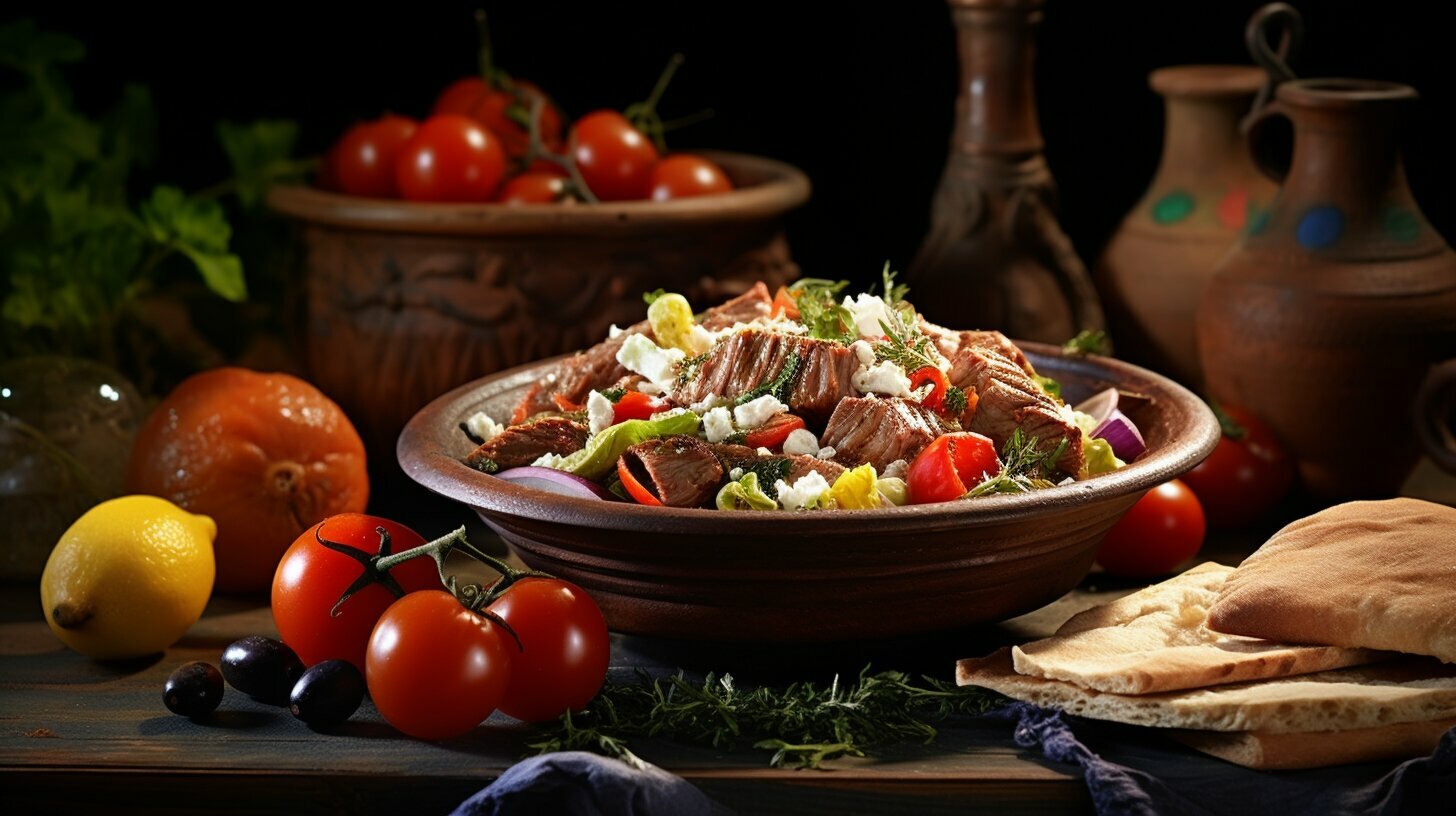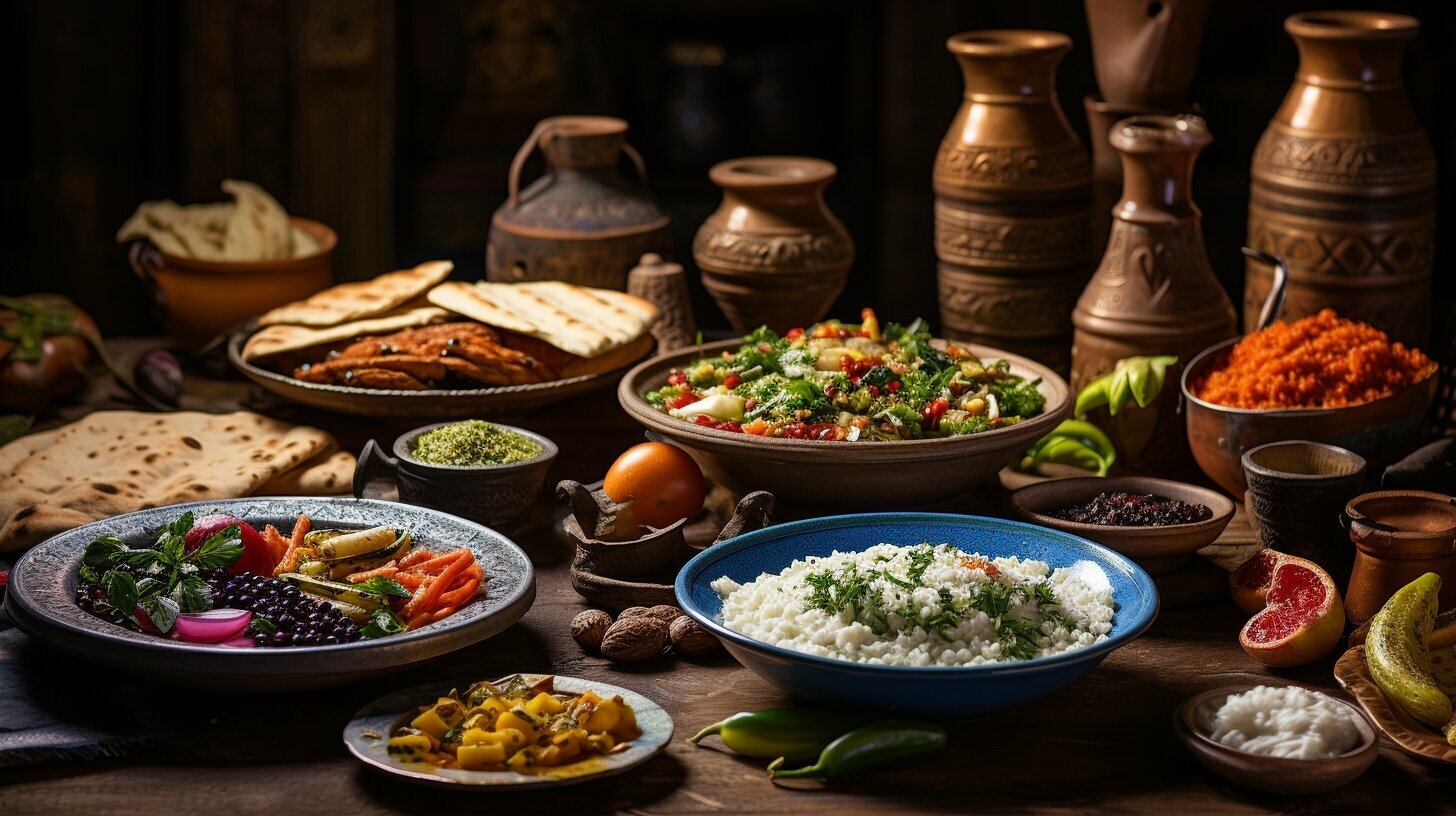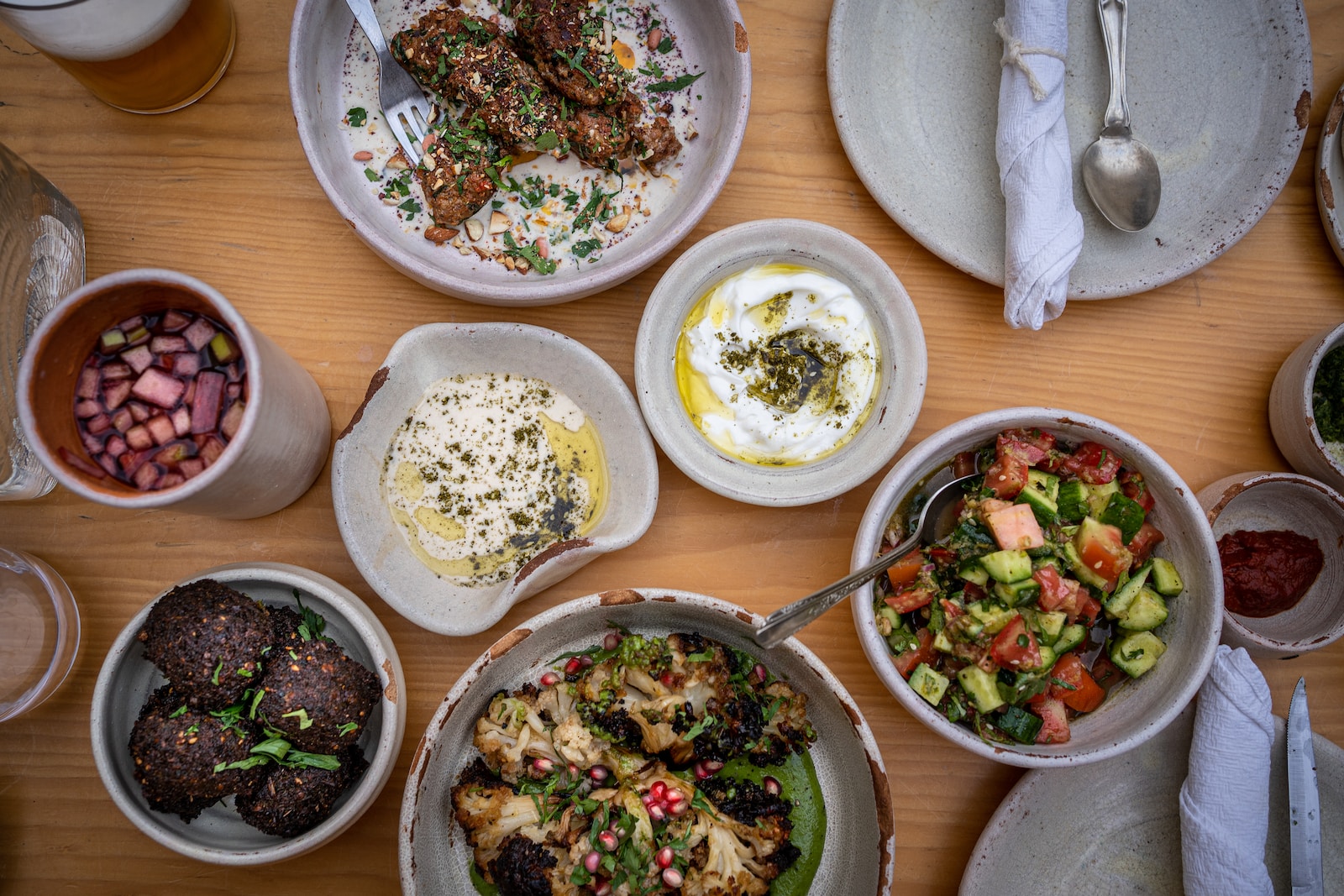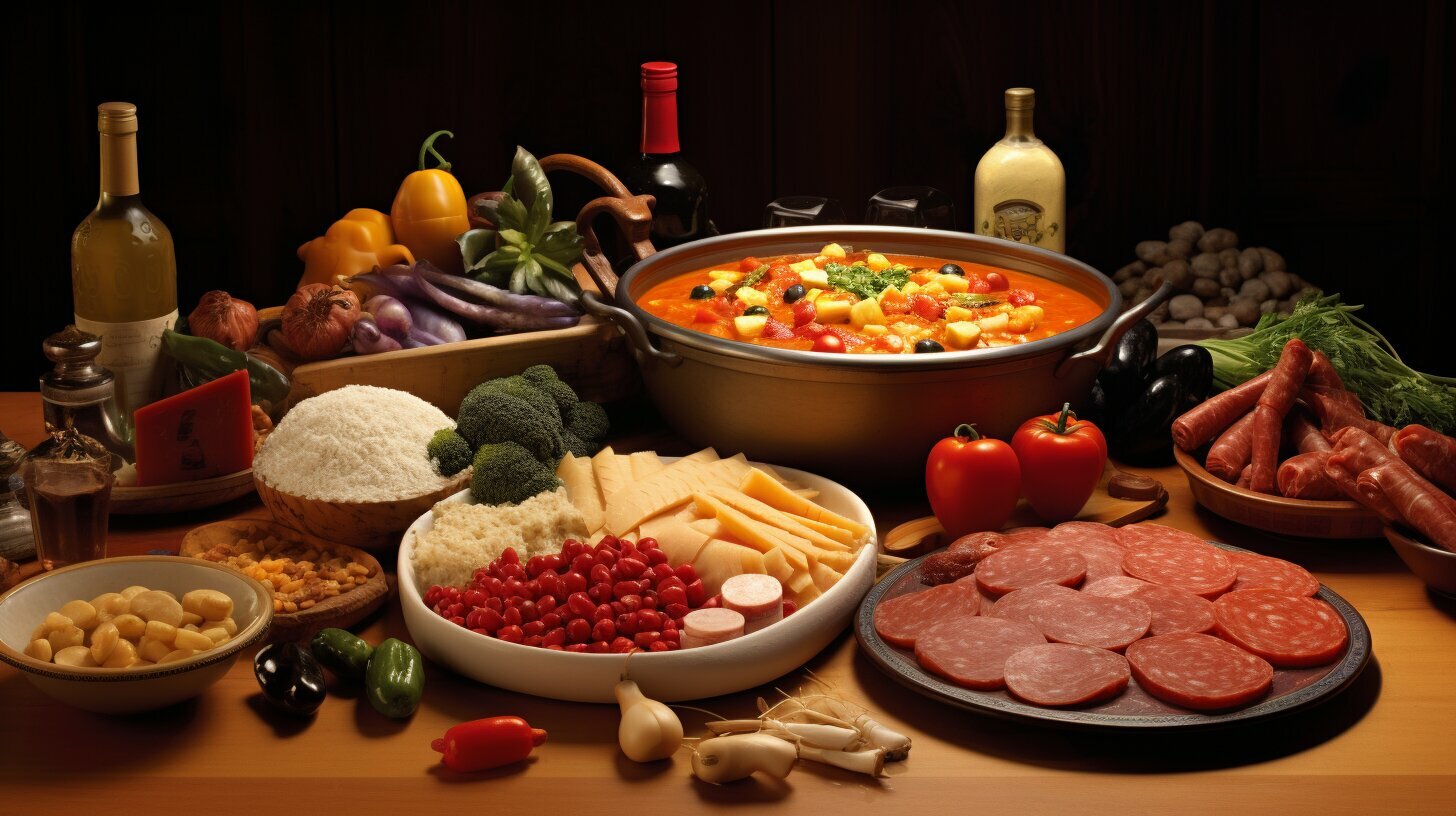When it comes to Mediterranean cuisine, Greek and Turkish food are two prominent players. While both cuisines share similarities, they also have distinct differences that set them apart. From traditional recipes to unique ingredients, the culinary traditions of Greece and Turkey are rich and diverse. Let’s explore what sets these delectable cuisines apart.
Key Takeaways:
- Greek and Turkish food share similarities but also have distinct differences.
- Mediterranean cuisine is an important part of both food cultures.
- Traditional recipes and unique ingredients play a significant role in Greek and Turkish food.
- Dining etiquette and food customs also differ between the two countries.
Flavors and Ingredients: A Journey Through Greek and Turkish Cuisine
Greek food and Turkish food are both part of the Mediterranean cuisine, using unique ingredients and flavors that have evolved over centuries. While there are many similarities between the two, there are also distinct differences that set them apart.
In Greek cuisine, olive oil is a staple ingredient used in nearly all dishes. The use of fresh herbs and spices, such as oregano, thyme, and rosemary, is also prominent. Additionally, Greek cuisine features a lot of vegetables, including eggplant, zucchini, and tomatoes. One of the unique ingredients in Greek cuisine is feta cheese, which is used in salads, as a topping for grilled meats, and in traditional dishes such as spanakopita.
Turkish cuisine also emphasizes the use of olive oil, along with spices such as cumin, coriander, and paprika. One of the signature ingredients in Turkish cuisine is yogurt, which is used as a condiment and in dishes such as cacik, a chilled soup made with cucumber and garlic. Another distinct ingredient is sumac, a tangy spice made from the berries of the sumac plant, which is used to flavor meat dishes and salads.
Both Greek and Turkish cuisines use unique ingredients and combinations of herbs and spices that create distinctive flavor profiles. Whether you prefer the bold flavors of Greek cuisine or the intricate spices of Turkish cuisine, both offer a delicious culinary adventure to savor and enjoy.
Unique Ingredients in Greek and Turkish Cuisine
| Greek Cuisine | Turkish Cuisine |
|---|---|
| Olive Oil | Olive Oil |
| Feta Cheese | Yogurt |
| Oregano, Thyme, Rosemary | Cumin, Coriander, Paprika |
| Eggplant, Zucchini, Tomatoes | Sumac, Mint, Dill |
Traditional Greek Dishes: From Moussaka to Souvlaki
Greek cuisine is known for its simple yet flavorful dishes, often made with fresh, locally-sourced ingredients. Traditional Greek recipes have been passed down through generations, and many of these dishes are still enjoyed today.
One of the most popular Greek dishes is moussaka, a layered casserole with eggplant, potatoes, ground beef, and a creamy béchamel sauce. It is typically served as a main course and is a symbol of Greek hospitality.
Souvlaki is another classic Greek dish, consisting of skewered meat (often lamb or chicken) grilled to perfection and served with pita bread, tzatziki sauce, and tomatoes. It is often enjoyed as a street food and is a staple of Greek cuisine.
Spanakopita, a spinach and feta cheese pie wrapped in flaky phyllo dough, is another beloved Greek dish. It is typically served as a snack or appetizer and is a great vegetarian option.
These traditional Greek dishes are not only delicious but also have cultural significance, representing the history and heritage of Greece. They are an important part of Greek food culture and are treasured by locals and visitors alike.
Authentic Turkish Delights: A Culinary Adventure
Turkish food is a vibrant and diverse cuisine that is steeped in culinary tradition. From savory kebabs to sweet baklava, Turkish dishes are known for their bold flavors and unique ingredients. Here are a few of the most beloved traditional recipes in Turkish cuisine:
| Dish | Description |
|---|---|
| Kebabs | Kebabs are a signature Turkish dish, featuring grilled or roasted meat cooked on a skewer and served with rice or bread. |
| Baklava | Baklava is a sweet pastry made with layers of phyllo dough, nuts, and honey syrup. It is a staple dessert in Turkish cuisine. |
| Lahmacun | Lahmacun is a thin, crispy flatbread topped with ground meat, vegetables, and herbs. It is a popular street food in Turkey. |
Turkish food is heavily influenced by Ottoman cuisine, which was known for its use of spices and herbs. Mint, parsley, and dill are commonly used in Turkish dishes, as well as cumin, sumac, and paprika. Olive oil is also a prominent ingredient in Turkish cuisine, as it is in Greek food.
Preparing traditional Turkish dishes is often a labor of love, with many recipes requiring hours of preparation and cooking time. However, the result is always worth it – a dish that is rich in flavor and steeped in cultural significance.
Food Culture and Culinary Traditions: Greek vs. Turkish
Greek and Turkish food not only have their own unique ingredients, but also their own distinct food cultures. In both countries, food holds a significant role in social gatherings, festivals, and celebrations.
In Greece, meals are seen as a time to bond and connect with loved ones. Family-style dining is common, with shared dishes like meze, souvlaki, and moussaka. The Greeks also have a strong appreciation for fresh, seasonal produce, and seafood due to their location along the Mediterranean Sea.
On the other hand, dining in Turkey is seen as a communal experience and a time to show hospitality. Guests are often served a variety of meze dishes followed by hot mains such as kebabs or stews. Turkish meals also include plenty of bread, salads, and dips.
When it comes to culinary traditions, Greece has a strong focus on regional specialties. Each region has its own unique cuisine, with certain dishes being associated with specific holidays or occasions. For example, tsoureki is a sweet bread eaten during Easter, while melomakarona is a honey-dipped cookie eaten during Christmas.
Meanwhile, in Turkey, many traditional dishes can be traced back to Ottoman cuisine. They are known for their flavorful stews and casseroles, like the famous Iskender kebab. And let’s not forget about their sweet treats, like baklava and Turkish delight.
While both countries share a love for food, there are some notable differences in dining etiquette. In Turkey, it is customary to remove your shoes before entering a home and to use your right hand to eat. In Greece, it is polite to leave a small portion of food on your plate to show that you have had enough, rather than finishing everything on your plate.
In conclusion, Greek and Turkish food cultures and culinary traditions may have some similarities, but they also have their own unique differences. These cultural nuances can make for a truly authentic dining experience when traveling to these Mediterranean destinations.
Conclusion
In conclusion, Greek and Turkish cuisines share many similarities due to their common Mediterranean heritage. However, both have unique flavor profiles and traditional dishes that set them apart. Greek cuisine, with its prominent use of olive oil, herbs, and feta cheese, is known for its delicate and refreshing flavors. Traditional dishes like moussaka and souvlaki are famous worldwide and have a rich cultural history.
On the other hand, Turkish cuisine boasts a rich blend of flavors and ingredients, influenced by its Ottoman heritage. The use of sweet and savory spices like cumin and cinnamon, along with vegetables like eggplant and peppers, make Turkish dishes distinctive and flavorful. Traditional dishes like kebabs and baklava are renowned for their rich taste and cultural significance.
The Importance of Experiencing Both Cuisines
While it’s fascinating to compare Greek and Turkish cuisines, it’s important to appreciate and experience both separately to truly understand their unique culinary heritages. Food is an essential part of both cultures, and their culinary traditions and customs reflect the rich history and culture of the region.
So, the next time you’re in the Mediterranean region, don’t miss the opportunity to taste the delicious delicacies of both Greek and Turkish cuisines. You won’t regret it!
FAQ
Q: What makes Greek and Turkish cuisine unique?
A: Greek and Turkish cuisine are both part of the Mediterranean culinary tradition, but they have their own distinct flavors and cooking techniques. Greek food often incorporates fresh herbs, olive oil, and unique ingredients like feta cheese and ouzo. Turkish food, on the other hand, is known for its rich flavors, spices, and influence from the Ottoman Empire.
Q: What are some traditional Greek dishes?
A: Traditional Greek dishes include moussaka, a layered casserole with eggplant and minced meat, and souvlaki, grilled skewers of marinated meat. Other beloved Greek dishes include spanakopita, a spinach and feta cheese pastry, and tzatziki, a yogurt and cucumber dip.
Q: What are some authentic Turkish dishes?
A: Authentic Turkish dishes include kebabs, such as döner kebab and shish kebab, lahmacun, a thin and crispy flatbread topped with minced meat and vegetables, and baklava, a sweet pastry made with layers of filo dough, nuts, and syrup.
Q: How does food culture differ between Greece and Turkey?
A: Food plays an important role in social gatherings, festivals, and celebrations in both Greece and Turkey. In Greece, a Mediterranean diet is emphasized, with a focus on fresh, locally sourced ingredients. Turkish food culture, influenced by its Ottoman heritage, places a strong emphasis on hospitality and sharing communal meals.
 Skip to main content
Skip to main content


